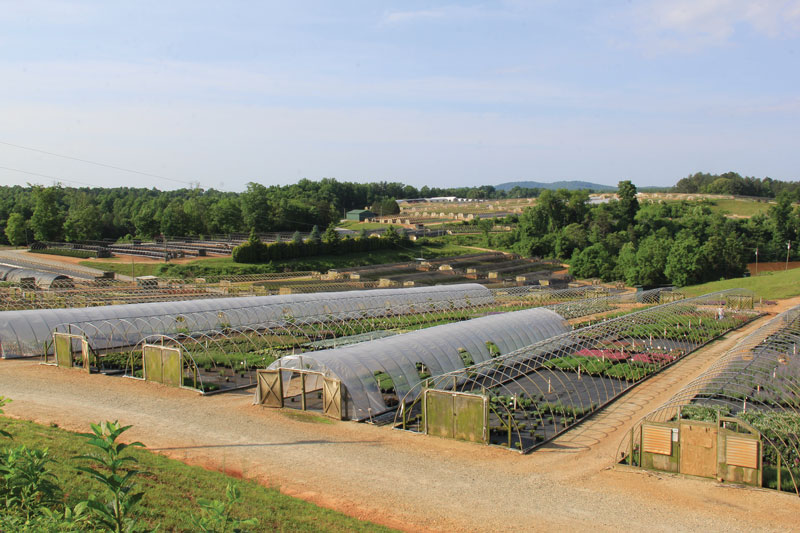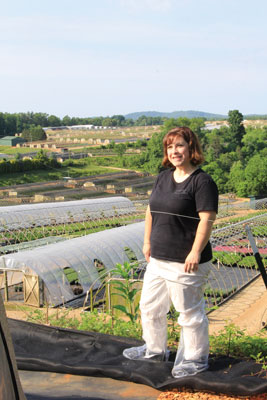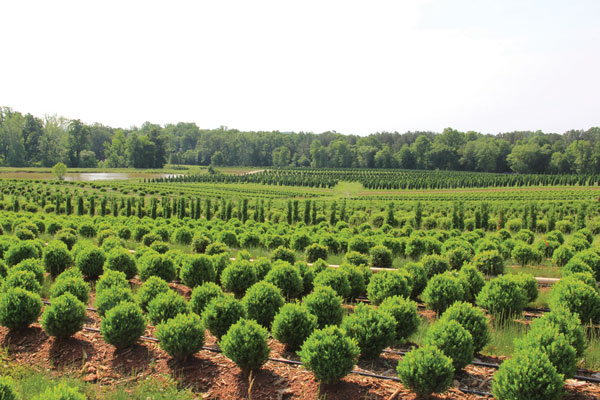7/1/2018
Keeping Blight at Bay
Jennifer Zurko

Pictured: The annuals houses at Saunders Brothers grow the bread-and-butter items for their landscape and independent retail customers. At the end of May, they were pretty empty.
Any grower worth his/her salt knows the ubiquitous boxwood. A staple of many a landscape, its versatility allows you to grow it in small round mounds, as a tall columnar shrub or trimmed into an interesting topiary.
The boxwood is what helped Saunders Brothers Nursery pop up on people’s radars. Founded as a partnership between Sam, Dick, Doc, William and Massie Saunders in 1915, it was strictly an apple and peach orchard to start, but in the 1940s Paul Saunders (Sam’s son) started to dabble in rooting boxwood as a 4-H project. He grew a few boxwood and decided to expand the nursery when he took over so that he could offer the results of his new passion to his customers.
Over 100 years later, Saunders Brothers is now run by the third generation and has expanded to five locations that total over 400 acres that offers not just orchard fruit and boxwood, but also annuals, perennials, shrubs and grafted trees.
You can never be too careful
Annual & Perennial Production Manager (and friend of GrowerTalks) Paul Westervelt took time out of his busy spring to drive me around two of the nurseries in Piney River, Virginia, to check out what they had going on. I say “drive around” because I was asked to stay in the car—and to wear protective pants and booties, walk through a serious foot bath going in and out of the front office, and sign a form saying that I hadn’t been frolicking with boxwoods lately.
Saunders Brothers doesn’t mess around because the recent wave of Boxwood Blight is nothing to mess with. According to
Dr. Jill Calabro, Science & Research Programs Director for AmericanHort, Boxwood Blight was first confirmed in the U.S. in October 2011 and since then it’s devastated the stock of many nurseries.
Jill said she’s still working on the exact numbers, but there have been significant losses, especially since it’s a brand-new disease that’s now establishing itself into landscapes. The number of reported cases has increased every year, “which could either indicate that Boxwood Blight is spreading or that folks are just more aware of it and looking for it, or probably a combination of both,” explained Jill.
 As of now, Saunders has been lucky—they haven’t experienced blight on any of their boxwood stock, which Paul attributes to their proactive, all-hands-on-deck mentality.
As of now, Saunders has been lucky—they haven’t experienced blight on any of their boxwood stock, which Paul attributes to their proactive, all-hands-on-deck mentality.
“When it raised its head, we really worked to get in front of it,” he said. “Even though we’ve never had it, we want to make sure it stays that way. We think of it as a matter of ‘when,’ not ‘if,’ so we’re extra cautious.”
Pictured: With the devastation caused by Boxwood Blight around the country, Saunders doesn’t take any chances. None of their stock has ever been infected and one of the reasons why is because they’re very cautious. They make visitors (like your editor) wear protective clothing and their staff practices strict sanitation protocols before and after they enter every boxwood production area.
Along with rigorous sanitation practices and allowing a minimum number of people into the boxwood nursery, Saunders has been hard at work to find out if there are differences between varieties with regard to blight resistance. Through their trialing and partnerships with Virginia Tech University and North Carolina State University, they’ve been able to pinpoint certain species as being more susceptible than others. For instance, Buxus sempervirens ‘Suffruticosa’ (also known as English Boxwood) is the most sensitive to blight.
They’ve also learned that the closer together you grow them and the denser they are, the riskier it is. Boxwood Blight is a fungus that likes moist conditions and lots of humidity, so the more air flow you have between the plants, the chances are lessened. It also doesn’t hurt that Saunders performs a regular regiment of fungicide sprays throughout the entire season.
Boxwood isn’t a quick-turn crop; they spend one year in the propagation stage and then up to another five years in the field. So when there’s a disease that’s wreaking havoc on years of production, it’s disheartening. Changing their offerings to less susceptible varieties helps, but it’s a slow process.
“It’s like turning a battleship right now,” said Robert Saunders, one of the four brothers that currently runs the business. “It takes a long time to turn that boat.”
One-stop-shop
Boxwood is what Saunders Brothers has become known for, but their product pie is sliced pretty evenly four ways between boxwood, annual/perennial color, other woody shrubs and orchard fruit.
 The different types of products may amount to an even volume, but the seasons aren’t the same, which helps Saunders keep a reliable, consistent pool of labor. When the annuals go out the greenhouse door in early spring, they switch to the fields to care for the boxwood and nursery stock, then move to the orchards to harvest at the end of the summer. It makes for a nice revolving door of tasks for their staff of more than 100 people.
The different types of products may amount to an even volume, but the seasons aren’t the same, which helps Saunders keep a reliable, consistent pool of labor. When the annuals go out the greenhouse door in early spring, they switch to the fields to care for the boxwood and nursery stock, then move to the orchards to harvest at the end of the summer. It makes for a nice revolving door of tasks for their staff of more than 100 people.
Pictured: Boxwood “soldiers” as far as the eye can see … Boxwood sales only make up 25% of Saunders Brothers’ business, but it’s what they’re best known for.
Their customer base is also split evenly—half landscape and half independent garden centers—and they ship as far north as Boston, as far south as Raleigh and as far west as Memphis.
During the recession, most nurseries cut back on their tree and shrub supply, which caused the significant shortage the industry is experiencing now. For crops that take years to produce, it was too risky for suppliers to grow product that their customers didn’t even know if they would need.
But for Saunders Brothers, they were able to maintain their stock—and even increase production—especially of their popular boxwoods. Saunders grows more than 20 different varieties of boxwood and sold more than 100,000 last year. Next year, they plan on doubling that number.
“The demand for boxwood has increased every year, regardless of blight and the recession,” said Paul.
Boxwood may only equal 25% of their total sales, but the team at Saunders holds the shrub that put them on the map in high regard.
“People think 90% of our business is boxwood—they’re surprised we have pansies,” laughs Paul. “But it’s because we market boxwood so well.” GT